Knowledge Mapping Analysis of Transnational Agricultural Land Investment Research
Abstract
:1. Introduction
- (1)
- Which journals and disciplines focus on TALI research?
- (2)
- What are the major researchers and institutions of TALI research?
- (3)
- What is the general trend of TALI research?
- (4)
- What are the hot topics, keywords and development paths of TALI research?
- (5)
- What are the challenges and frontiers of TALI research?
2. Methods and Data
3. Literature Characteristics of TALI Research
3.1. Major Journals and Disciplines
3.2. Researchers and Institutions
4. Research Trends of TALI
4.1. The Evolution of Research Topics
- (1)
- The embryonic stage (2005–2007)—a period of slow increase in the research results of TALI, with a total of 11 journal articles, accounting for about 2% of the total analyzed literature. At this stage, the total number of journal articles was small, and TALI was not studied enough. The research topics mainly focused on investment, impact, governance, livelihoods, etc. In addition, the research topics such as land property rights, forests, property rights and farmers were evolved. The research topics of TALI mainly focused on transnational agricultural investment and agricultural outward investment. The main findings of the relevant studies are on the impact of TALI for the agricultural environment, farmers in the host country, agricultural growth in developing countries and anti-poverty. However, land property rights and land systems issues became an important basis for topic development [24,25,26,27,28,29].
- (2)
- The growth stage (2008–2013)—a period of rapid growth in TALI research, with a total of 218 journal articles, accounting for 30.4% of the total analyzed literature. Research topics at this stage began to spread to food security, political economy, land grabbing and bioenergy, and evolved into topics such as land acquisition, climate change, forest land degradation and large-scale land acquisitions. In fact, influenced by the global food crisis in 2007–2008, some major food importing countries, financial institutions and transnational agricultural investment companies had an increased investment in transnational agricultural land, leading to an explosive growth in both the scale and the research results of TALI during this period. During this period, TALI attracted the attention of researchers in many fields, and relevant research topics gradually extended to land systems, agricultural development, farmers’ rights, biofuel industry development, market speculation, natural resource control and food consumption in emerging economies, etc. [30,31,32,33,34].
- (3)
- The stable stage (2014–2019)—a period of steady development for the research of TALI. There was a total of 488 journal articles, accounting for about 68.1% of the total analyzed literature, but the fluctuations and growth rates of the total annual publications were not high. At this stage, the research topics focused on women’s rights, land financialization and governance, and found new topics such as land governance, sustainability and security. During this period, the threat of the global food crisis diminished, and the global economy gradually emerged from the financial crisis, the fervor of TALI and the speculative investment of financial institutions decreased at the same time. In order to guide TALI research to focus on land system construction, some international organizations, investor country’s governments and host country’s governments issued a series of guidelines to regulate TALI. The topics covered the regulation of corporate investment behavior, smallholder livelihoods, ecological environmental protection, etc. [35,36,37,38,39,40].
4.2. Research Hotspots
4.2.1. High-Frequency Keywords
4.2.2. Keywords Development Path
4.3. Research Frontier Identification
5. Conclusions
- (1)
- From the perspective of journal and discipline characteristics, more articles relating to TALI research have been published and TALI research has a relatively higher influence in the Journal of Peasant Studies and Land Use Policy than other journals, and these can be considered to be the core journals in the field of current TALI research. In addition, related results are also published in high volume in journals related to the following five disciplines: “Social Sciences”, “Development Studies”, “Economics”, “Environmental Sciences” and “Geography”, especially in journals on “Development Studies”, Therefore, TALI research is an interdisciplinary topic.
- (2)
- In terms of high-yield scholars and institutions on TALI research and their publications, Borras has the highest number of publications, followed by Rulli, D’Odorico and Scoones, who are core authors in the field of TALI research. In terms of cooperation network, the research on TALI presents the characteristics of partial concentration and overall dispersion. That is, TALI research has formed several core research teams, but the connection strength is very weak and the degree of integration between the teams is not high. Research institutions are mainly concentrated in universities, followed by research institutes. The degree of connection and cooperation among institutions is low, and academic exchanges need to be strengthened.
- (3)
- In terms of research themes, the evolution of the research theme of TALI has roughly experienced the following three stages: the embryonic stage, the growth stage and the stable stage. The research topics are gradually enriched, and the research content also shows a trend of continuous divergence and deepening.
- (4)
- In terms of research hotspots, “Land Grabbing”, “Global Land”, “Africa” and “Investment” have been the research hotspots in TALI research in recent years. The co-occurrence map of keywords in the research of TALI roughly develops along seven directions, and the research perspectives tend to be diversified and show the trend of interdisciplinary nature.
- (5)
- In terms of research frontiers, the burst terms’ analysis revealed that “Indonesia”, “Livelihood”, “Trajectory” and “Sustainability” are hot research topics in the field of TALI research at present.
Author Contributions
Funding
Institutional Review Board Statement
Informed Consent Statement
Data Availability Statement
Conflicts of Interest
References
- Food and Agriculture Organization (FAO). The Future of Food and Agriculture-Alternative Pathways to 2050s; Food and Agriculture Organization: Rome, Italy, 2018. [Google Scholar]
- Food and Agriculture Organization (FAO). Principles for Responsible Investment in Agriculture and Food Systems; Food and Agriculture Organization: Rome, Italy, 2014. [Google Scholar]
- Schutter, O.D. How not to think of land-grabbing: Three critiques of large-scale investments in farmland. J. Peasant. Stud. 2011, 38, 249–279. [Google Scholar] [CrossRef]
- Fairhead, J.; Leach, M.; Scoones, I. Green grabbing: A new appropriation of nature? J. Peasant. Stud. 2012, 39, 237–261. [Google Scholar] [CrossRef] [Green Version]
- Anseeuw, W.; Lay, J.; Messerli, P.; Giger, M.; Taylor, M. Creating a public tool to assess and promote transparency in global. J. Peasant. Stud. 2013, 40, 521–530. [Google Scholar] [CrossRef] [Green Version]
- Han, J.; Chen, Z.; Lu, X. Spatiotemporal change of China’s overseas investment in farmlands and influencing factors. Resour. Sci. 2020, 42, 1715–1727. [Google Scholar] [CrossRef]
- Han, J.; Lu, X.; Kuang, B. Analysis of the spatial distribution and geo-relationship factors influencing paths of host countries for China’s overseas farmland investment. China Land Sci. 2020, 34, 79–88. [Google Scholar]
- Lu, X.; Han, J. Review of studies on overseas farmland investment. China Land Sci. 2014, 28, 88–96. [Google Scholar]
- Borras, S.M.; Kay, C.G.; Sergio, W.J. Land grabbing and global capitalist accumulation: Key features in Latin America. Revue Canadienne D’études Du Développement 2012, 33, 402–416. [Google Scholar] [CrossRef]
- Schoneveld, G.C. Host country governance and the African land rush: 7 reasons why large-scale farmland investments fail to contribute to sustainable development. Geoforum 2017, 83, 119–132. [Google Scholar] [CrossRef]
- Zoomers, A.; Otsuki, K. Addressing the impacts of large-scale land investments: Re-engaging with livelihood research. Geoforum 2017, 83, 164–171. [Google Scholar] [CrossRef]
- Holmes, G. What is a land grab? Exploring green grabs, conservation, and private protected areas in southern Chile. J. Peasant. Stud. 2014, 41, 547–567. [Google Scholar] [CrossRef]
- Siciliano, G.; Rulli, M.C.; D’odorico, P. European large-scale farmland investments and the land-water-energy-food nexus. Adv. Water Resour. 2017, 110, 579–590. [Google Scholar] [CrossRef] [Green Version]
- Herrmann, R.T. Large-scale agricultural investments and smallholder welfare: A comparison of wage labor and outgrowth channels in Tanzania. World Dev. 2016, 90, 294–310. [Google Scholar] [CrossRef]
- Balestri, S.; Maggioni, M.A. This land is my land! Large-scale land acquisitions and conflict events in Sub-Saharan Africa. Defence Peace. Econ. 2021, 32, 427–450. [Google Scholar] [CrossRef]
- Kariuki, F.; Ng’Etich, R. Land grabbing, tenure security and livelihoods in Kenya. SSRN Electron. J. 2016, 2, 79–99. [Google Scholar] [CrossRef] [Green Version]
- Vijayabaskar, M.; Menon, A. Dispossession by neglect: Agricultural land sales in Southern Indian. J. Agrar. Chang. 2018, 3, 571–587. [Google Scholar] [CrossRef]
- Lu, X.; Li, Y.; Ke, S. Spatial distribution pattern and its optimization strategy of China’s overseas farmland investments. Land Use Policy 2019, 91, 104355. [Google Scholar] [CrossRef]
- Chen, Y.; Chen, C.; Liu, Z.; Hu, Z.; Wang, X. The methodology function of citespace mapping knowledge domains. Stud. Sci. Sci. 2015, 33, 242–253. [Google Scholar]
- Long, H.; Zhang, Y.; Ma, L.; Tu, S. Land use transitions: Progress, challenges and prospects. Land 2021, 10, 903. [Google Scholar] [CrossRef]
- Ding, X.; Yang, Z. Mapping of platform research: A visual analysis using VOS viewer and CiteSpace. Electron. Commer. Res. 2020, 1–23. [Google Scholar]
- Jia, G.; Ma, R.; Hu, Z. Review of urban transportation network design problems based on citespace. Math. Probl. Eng. 2019, 2019, 1–22. [Google Scholar] [CrossRef]
- Wan, K.; Lu, X. Research on the impact factors on selecting host countries of China’s overseas farmland investment: An empirical study based on gravity model and random utility model. China Land Sci. 2018, 32, 75–81. [Google Scholar]
- Sun, Z.; Jia, S.; Lv, A. The status of China’s overseas farmland investment. Resour. Sci. 2018, 40, 1495–1504. [Google Scholar]
- Zheng, L.; Liu, Z. Spatial pattern of Chinese outward direct investment in the Belt and Road Initiative area. Pro. Phys. Geog. 2015, 34, 563–570. [Google Scholar]
- Olesen, T. Transnational agrarian movements confronting globalization. J. Agrar. Chang. 2009, 9, 578–582. [Google Scholar] [CrossRef]
- Amp, S.; Leite, S.P. Agrarian structure, foreign investment in land, and land prices in Brazil. J. Peasant. Stud. 2012, 39, 873–898. [Google Scholar]
- Johan, L.C. Agricultural policy uncertainty and farm level adjustments: The case of direct payments and incentives for farmland investment. Eur. Rev. Agric. Econ. 2005, 1, 1–23. [Google Scholar]
- Deininger, K. Challenges posed by the new wave of farmland investment. J. Peasant. Stud. 2011, 38, 217–247. [Google Scholar] [CrossRef]
- Lee, J. Contemporary land grabbing: Research sources and bibliography. SSRN Electron. J. 2015, 107, 259–285. [Google Scholar]
- McCarthy, J.F.; Jacqueline, A.C.; Afiff, S.A. Trajectories of land acquisition and enclosure: Development schemes, virtual land grabs, and green acquisitions in Indonesia’s outer islands. J. Peasant. Stud. 2012, 39, 521–549. [Google Scholar] [CrossRef]
- Krause, M.; Lotze-Ca Mpen, H.; Popp, A.; Dietrich, J.P.; Bonsch, M. Conservation of undisturbed natural forests and economic impacts on agriculture. Land Use Policy 2013, 30, 344–354. [Google Scholar] [CrossRef]
- Collins, A.M. Governing the global land grab: What role for gender in the voluntary guidelines and the principles for responsible investment? Globalizations 2014, 11, 189–203. [Google Scholar] [CrossRef]
- Zoomers, A.; van Noorloos, F.; Otsiki, K.; Steel, G.; Westen, G.V. The rush for land in an urbanizing world: From land grabbing toward developing safe, resilient, and sustainable cities and landscapes. World Dev. 2017, 2, 242–252. [Google Scholar] [CrossRef]
- Carter, S.; Manceur, A.M.; Seppelt, R.; Hermansneumann, K.; Herold, M.; Verchot, L.V. Large-scale land acquisitions and REDD+: A synthesis of conflicts and opportunities. Environ. Res. Lett. 2017, 12, 1–11. [Google Scholar] [CrossRef]
- Knuth, S.E. Global finance and the land grab: Mapping twenty-first century strategies. Can. J. Dev. Stud. 2015, 36, 163–178. [Google Scholar] [CrossRef]
- Nally, D. Governing precarious lives: Land grabs, geopolitics, and “food security”. Geographical 2015, 181, 340–349. [Google Scholar] [CrossRef] [Green Version]
- Ducastel, A.; Anseeuw, W. Agriculture as an asset class: Reshaping the South African farming sector. Agric. Hum. Values 2017, 34, 199–209. [Google Scholar] [CrossRef] [Green Version]
- Oliveira, G.D.L.T.; Mckay, B.M.; Liu, J. Beyond land grabs: New insights on land struggles and global agrarian change. Globalizations 2020, 18, 321–338. [Google Scholar] [CrossRef]
- Verma, R. Land grabs, power, and gender in East and Southern Africa: So, What’s new? Fem. Econ. 2014, 20, 52–75. [Google Scholar] [CrossRef]
- Adams, E.A.; Kuusaana, E.D.; Ahmed, A.; Campion, B.B. Land dispossessions and water appropriations: Political ecology of land and water grabs in Ghana. Land Use Policy 2019, 87, 40–68. [Google Scholar] [CrossRef]
- Tienhaara, K. The potential perils of forest carbon contracts for developing countries: Cases from Africa. J. Peasant. Stud. 2012, 39, 551–572. [Google Scholar] [CrossRef]
- Lyons, K.; Westoby, P. Carbon colonialism and the new land grab: Plantation forestry in Uganda and its livelihood impacts. J. Rural Stud. 2014, 36, 13–21. [Google Scholar] [CrossRef]
- Corbera, E.; Hunsberger, C.; Vaddhanaphuti, C. Climate change policies, land grabbing and conflict: Perspectives from Southeast Asia. Can. J. Dev. Stud. 2017, 38, 297–304. [Google Scholar] [CrossRef]
- Rulli, M.C. Global land and water grabbing. Proc. Natl. Acad. Sci. USA 2013, 110, 892–897. [Google Scholar] [CrossRef] [Green Version]
- Mensah, E.; Omulo, G. Youth’s access to agricultural land in Sub-Saharan Africa: A missing link in the global land grabbing discourse. Land Use Policy 2019, 89, 104210. [Google Scholar]
- Borras, S.M.; Franco, J. Global land grabbing and political reactions ‘from below’. Third World Q 2013, 34, 1723–1744. [Google Scholar] [CrossRef]
- Davis, F.K.; Rulli, M.C.; Pichdara, L.; D’Odorico, P. Accelerated deforestation driven by large-scale land acquisitions in Cambodia. Nat. Geosci. 2015, 11, 772–775. [Google Scholar] [CrossRef] [Green Version]
- Andrea, M.C. Financialization, resistance, and the question of women’s land rights. Int. Fem. J. Polit. 2018, 11, 1–22. [Google Scholar]
- Martina, L. ‘How come others are selling our land?’ Customary land rights and the complex process of land acquisition in Tanzania. J. East Afr. Stud. 2016, 10, 1–20. [Google Scholar]
- Kircher, M. Bioeconomy: Markets, implications, and investment opportunities. Economies 2019, 7, 73. [Google Scholar] [CrossRef] [Green Version]
- Oberlack, C.; Tejada, L.; Messerli, P.; Rist, S.; Giger, M. Sustainable livelihoods in the global land rush? Archetypes of livelihood vulnerability and sustainability potentials. Global Environ. Chang. 2016, 41, 153–171. [Google Scholar] [CrossRef] [Green Version]
- Duy, L.V.; Amekawa, Y.; Isoda, H.; Nomura, H.; Watanabe, T. Are socialist domestic land grabs egalitarian? Insights from a case involving a rubber plantation in Dien Bien Province, Vietnam. Geoforum 2020, 114, 89–106. [Google Scholar]
- Jung, S. Evidence on land deals’ impacts on local livelihoods. Curr. Opin. Env. Sust. 2018, 32, 90–95. [Google Scholar] [CrossRef]
- Messerli, P.; Giger, M.; Dwyer, M.B.; Breu, T.; Eckert, S. The geography of large-scale land acquisitions: Analysing socio-ecological patterns of target contexts in the global south. Appl. Geogr. 2014, 53, 449–459. [Google Scholar] [CrossRef]
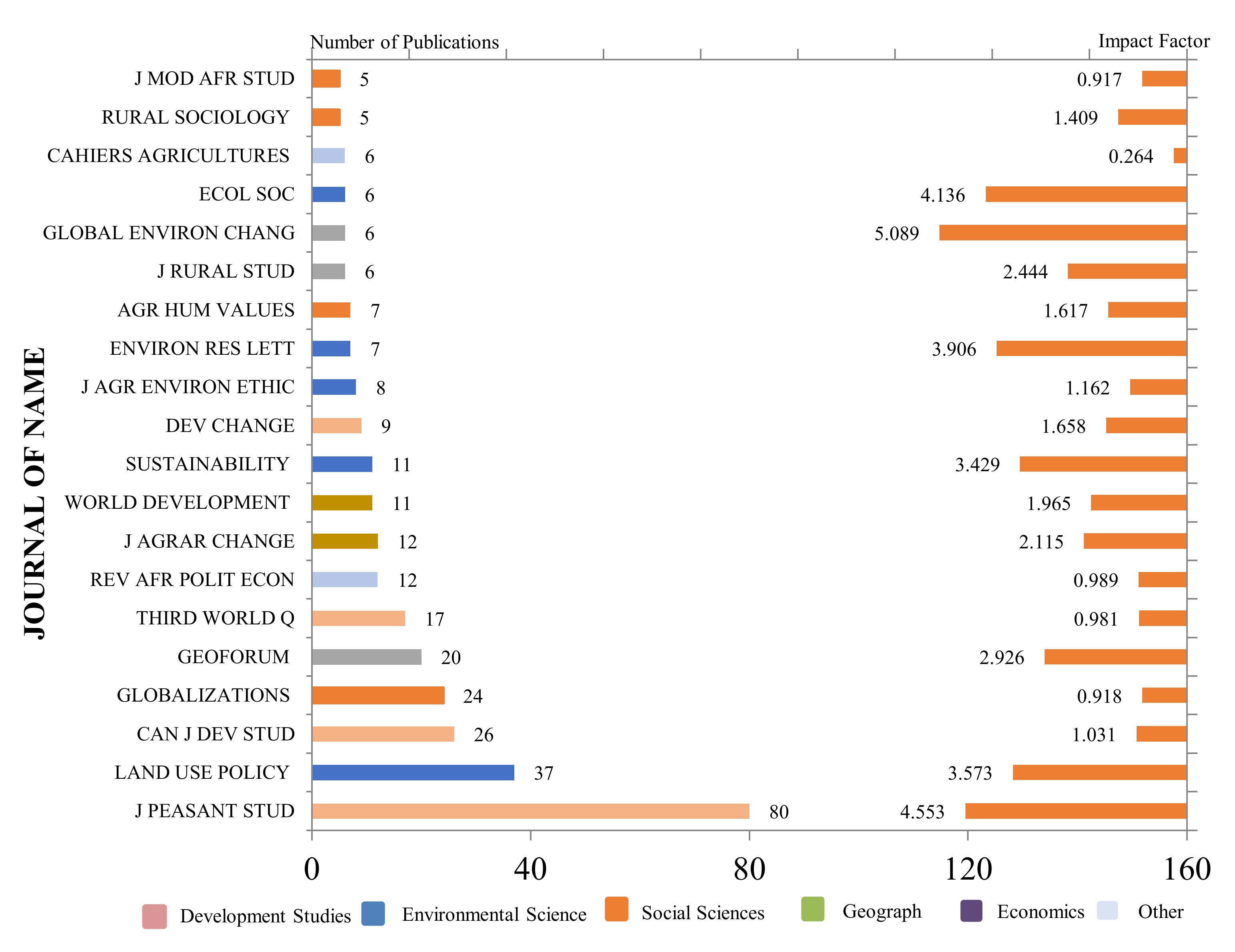
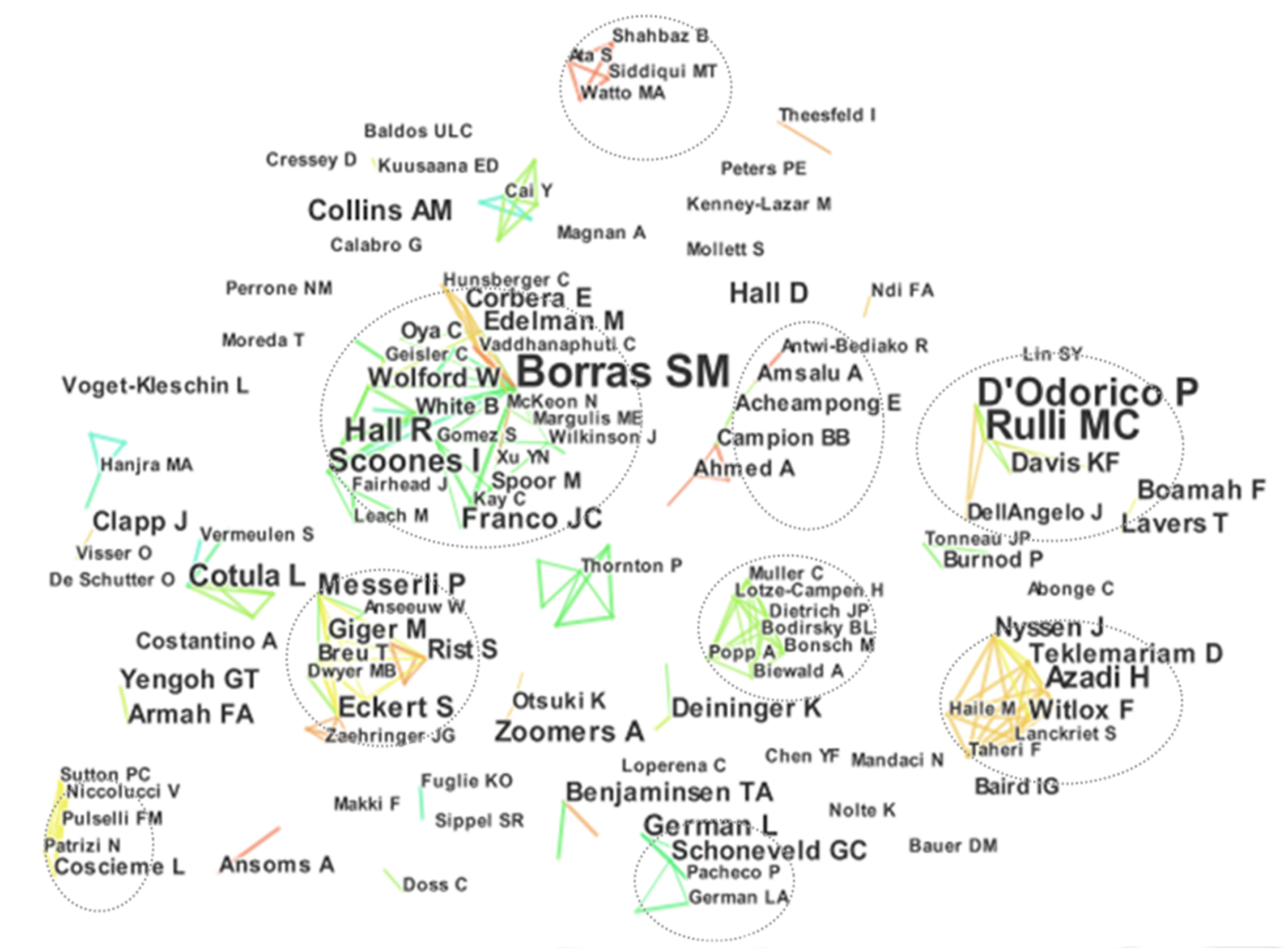
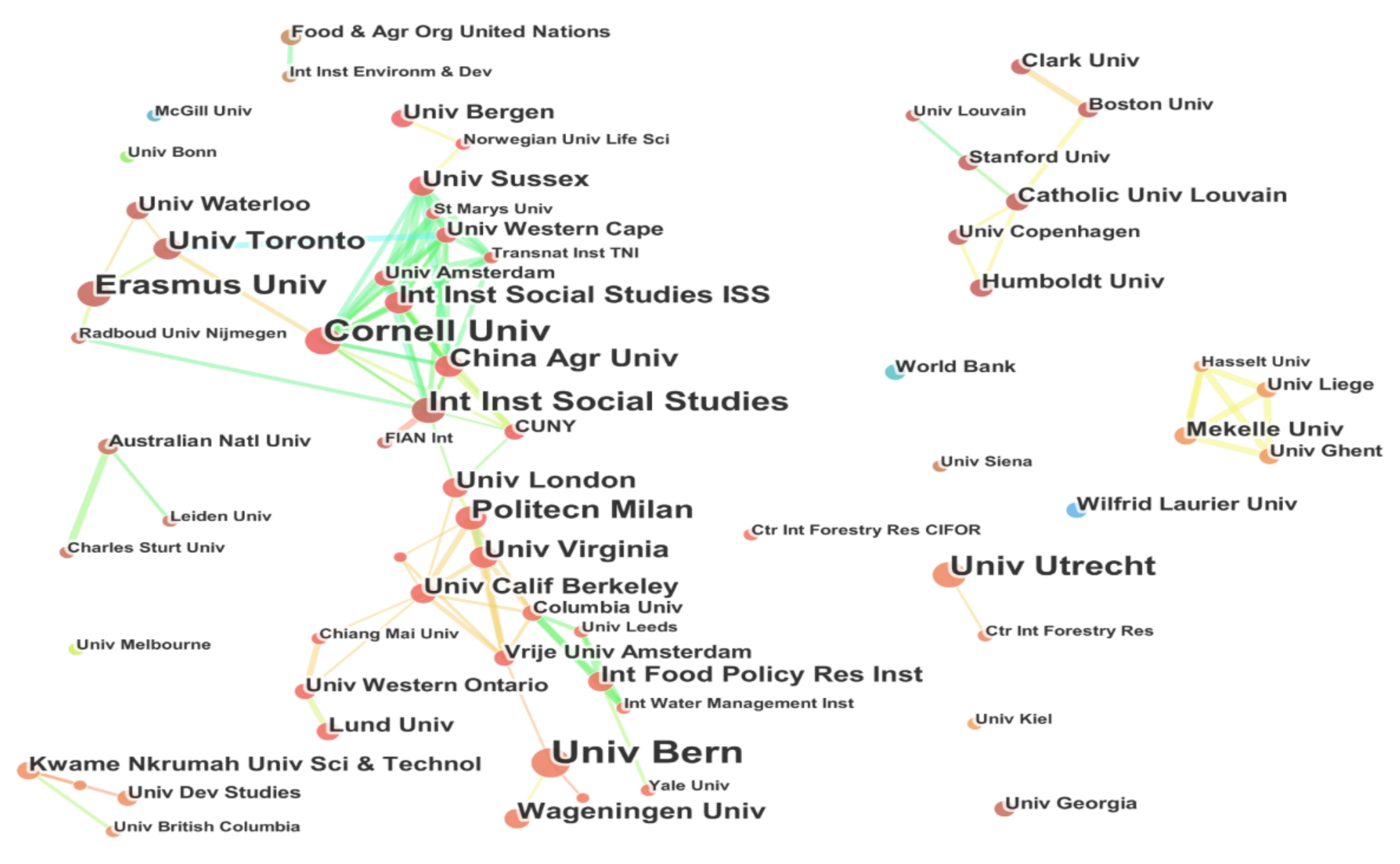
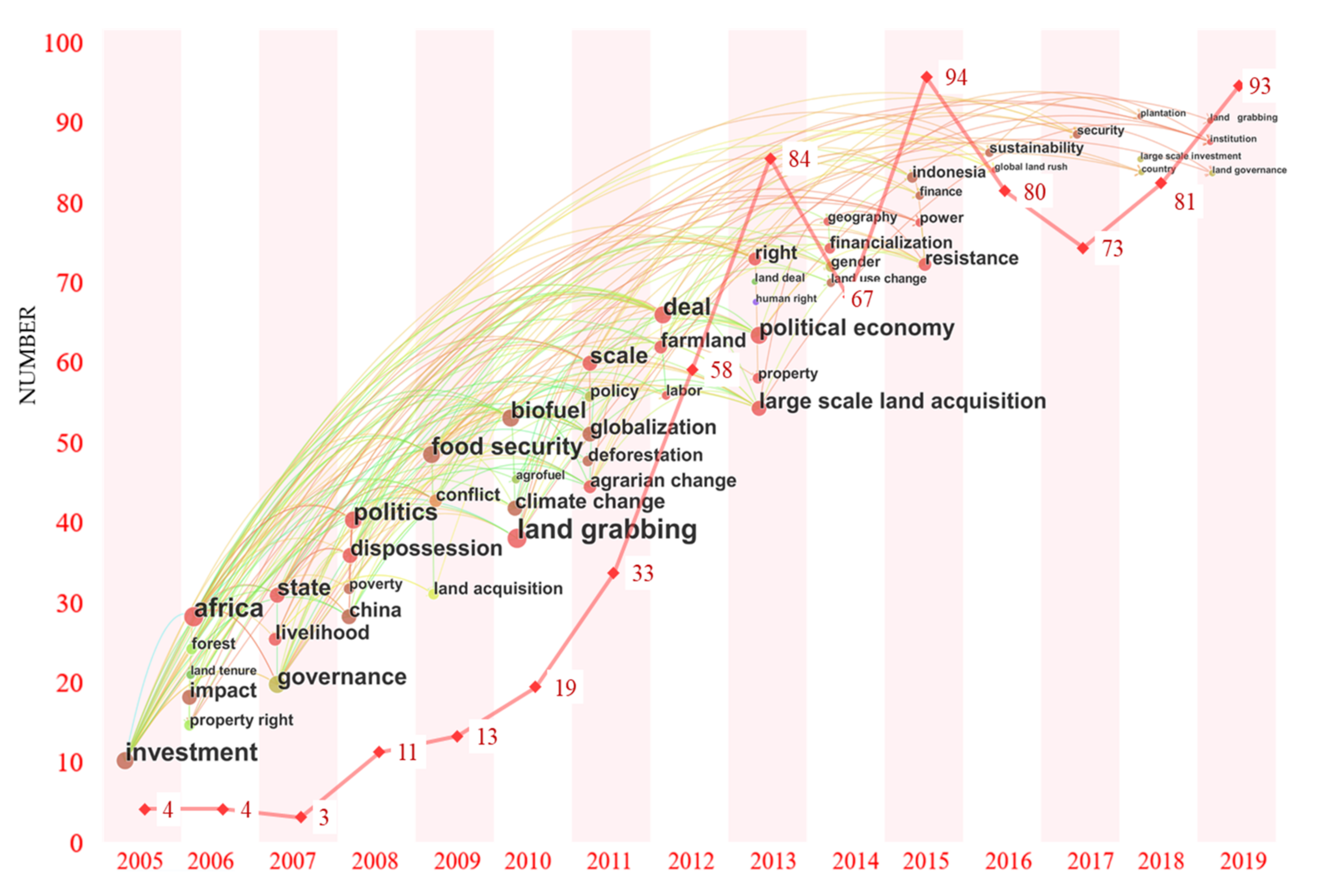
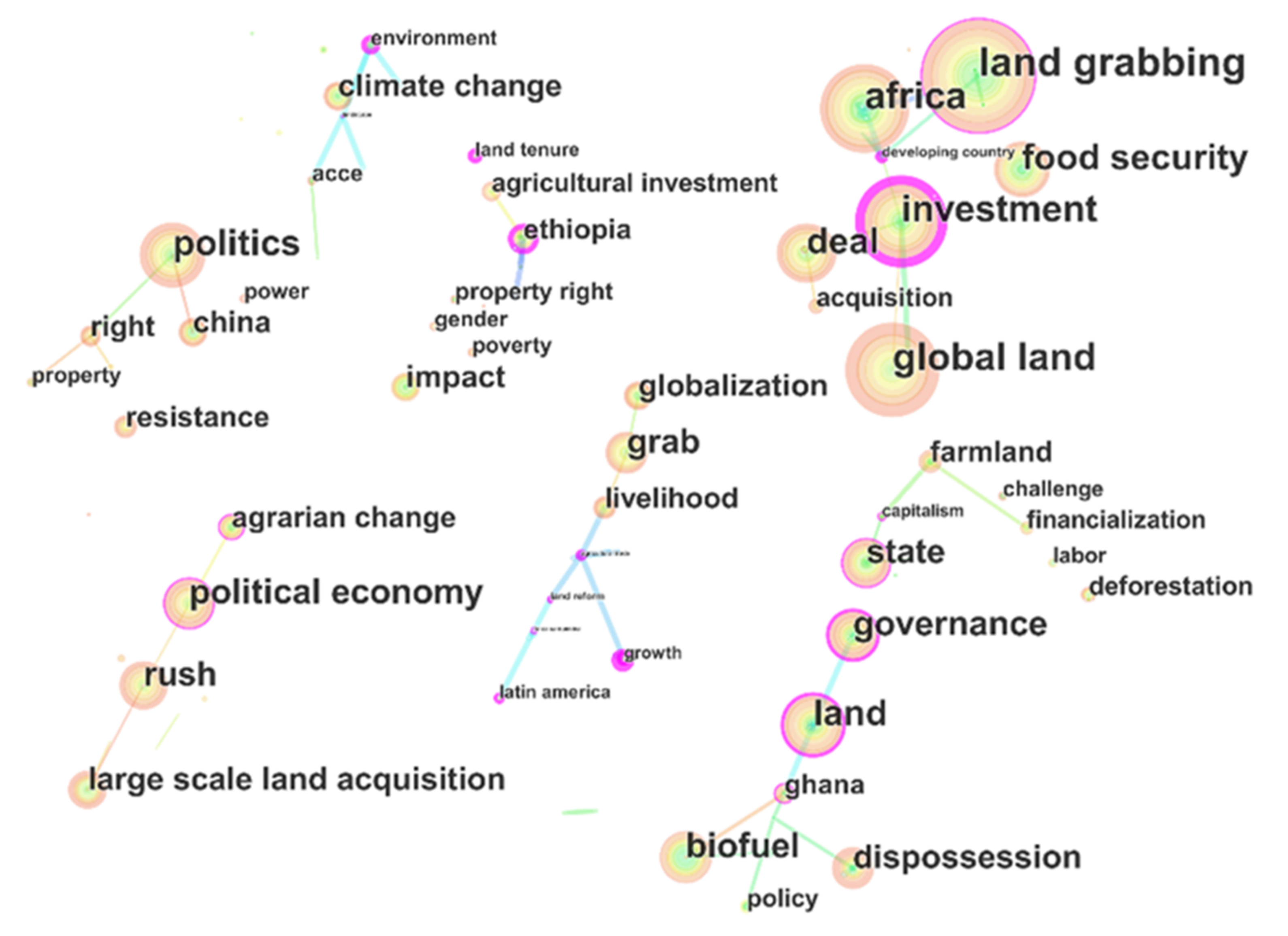
| Number | Publications | Author | Institution | Year of Earliest Publication |
|---|---|---|---|---|
| 1 | 18 | Borras SM. | Erasmus University Rotterdam | 2007 |
| 2 | 12 | Rulli MC | Polytechnic University of Milan | 2013 |
| 3 | 11 | D’Odorico P | University of California, | 2013 |
| 4 | 7 | Scoones I | Institute of Development Studies | 2010 |
| 5 | 7 | Hall R | University of the Western Cape | 2011 |
| 6 | 6 | Cotula L | International Institute for Environment and Development | 2009 |
| 7 | 5 | Eckert S | Universität of Bern | 2014 |
| 8 | 5 | Zoomers A | Utrecht of University | 2010 |
| 9 | 5 | Messerli P | Universität of Bern | 2013 |
| 10 | 5 | Collins AM | University of Waterloo | 2013 |
| 11 | 5 | Hall D | University of Wilfrid Laurier | 2011 |
| 12 | 5 | German L | Center for International Forestry Research | 2011 |
| 13 | 4 | Deininger K | World Bank | 2006 |
| 14 | 4 | Schoneveld G.C. | Center for International Forestry Research | 2011 |
| 15 | 4 | Wolford W. | Cornell University | 2013 |
| Number | Publications | Betweenness Centrality | Institution | Country |
|---|---|---|---|---|
| 1 | 22 | 0.03 | University of Bern | Switzerland |
| 2 | 17 | 0.02 | Cornell University | American |
| 3 | 13 | 0.00 | Erasmus University | Switzerland |
| 4 | 13 | 0.07 | International Institution of Social Studies | Switzerland |
| 5 | 13 | 0.00 | University Utrecht | Switzerland |
| 6 | 12 | 0.04 | Polytechnic University of Milan | Italy |
| 7 | 10 | 0.02 | University of Toronto | Canada |
| 8 | 10 | 0.00 | China Agricultural University | China |
| 9 | 9 | 0.00 | University of Virginia | American |
| 10 | 8 | 0.01 | Wageningen University | Switzerland |
| 11 | 8 | 0.08 | University of London | Britain |
| 12 | 7 | 0.02 | University of Sussex | Britain |
| 13 | 7 | 0.06 | University of Calif Berkeley | American |
| 14 | 7 | 0.05 | International Food Policy Research Institute | American |
| 15 | 6 | 0.00 | University of Waterloo | Canada |
| Number | Frequency | Keywords | Year of Occurrence | Betweenness Centrality |
|---|---|---|---|---|
| 1 | 118 | Land Grabbing | 2010 | 0.11 |
| 2 | 101 | Global Land | 2013 | 0.05 |
| 3 | 98 | Africa | 2008 | 0.51 |
| 4 | 91 | Land Grab | 2010 | 0.06 |
| 5 | 85 | Investment | 2005 | 0.39 |
| 6 | 75 | Agriculture | 2010 | 0.06 |
| 7 | 70 | Politics | 2011 | 0.04 |
| 8 | 65 | Deal | 2013 | 0.04 |
| 9 | 65 | Food Security | 2009 | 0.05 |
| 10 | 64 | Land | 2011 | 0.01 |
| 11 | 59 | Biofuel | 2009 | 0.02 |
| 12 | 57 | Governance | 2011 | 0.15 |
| 13 | 55 | Political Economy | 2013 | 0.02 |
| 14 | 55 | Rush | 2013 | 0.02 |
| 15 | 54 | Scale | 2011 | 0.15 |
| 16 | 51 | Dispossession | 2011 | 0.04 |
| 17 | 50 | State | 2011 | 0.04 |
| 18 | 47 | Grab | 2013 | 0.07 |
| 19 | 44 | Large-scale Land Acquisition | 2013 | 0.05 |
| 20 | 37 | Globalization | 2011 | 0.03 |
| Number | Burst Terms | Period | Burstiness |
|---|---|---|---|
| 1 | Forest | 2006–2015 | 2.7133 |
| 2 | Biofuel | 2010–2012 | 5.4584 |
| 3 | Reform | 2011–2013 | 4.7414 |
| 4 | Market | 2011–2015 | 2.7849 |
| 5 | Policy | 2011–2016 | 2.8932 |
| 6 | Land Grab | 2012–2014 | 2.7491 |
| 7 | Capitalism | 2012–2014 | 2.6061 |
| 8 | Accumulation | 2013–2016 | 3.1216 |
| 9 | Land Acquisition | 2013–2016 | 4.6951 |
| 10 | Land Use Change | 2014–2016 | 2.5261 |
| 11 | Finance | 2015–2017 | 2.8395 |
| 12 | Indonesia | 2015–2019 | 3.1348 |
| 13 | Livelihood | 2015–2019 | 2.5674 |
| 14 | Trajectory | 2016–2019 | 2.6464 |
| 15 | Sustainability | 2016–2019 | 3.3117 |
Publisher’s Note: MDPI stays neutral with regard to jurisdictional claims in published maps and institutional affiliations. |
© 2021 by the authors. Licensee MDPI, Basel, Switzerland. This article is an open access article distributed under the terms and conditions of the Creative Commons Attribution (CC BY) license (https://creativecommons.org/licenses/by/4.0/).
Share and Cite
Han, J.; Jiang, M.; Zhang, X.; Lu, X. Knowledge Mapping Analysis of Transnational Agricultural Land Investment Research. Land 2021, 10, 1374. https://doi.org/10.3390/land10121374
Han J, Jiang M, Zhang X, Lu X. Knowledge Mapping Analysis of Transnational Agricultural Land Investment Research. Land. 2021; 10(12):1374. https://doi.org/10.3390/land10121374
Chicago/Turabian StyleHan, Jing, Mengying Jiang, Xupeng Zhang, and Xinhai Lu. 2021. "Knowledge Mapping Analysis of Transnational Agricultural Land Investment Research" Land 10, no. 12: 1374. https://doi.org/10.3390/land10121374
APA StyleHan, J., Jiang, M., Zhang, X., & Lu, X. (2021). Knowledge Mapping Analysis of Transnational Agricultural Land Investment Research. Land, 10(12), 1374. https://doi.org/10.3390/land10121374







